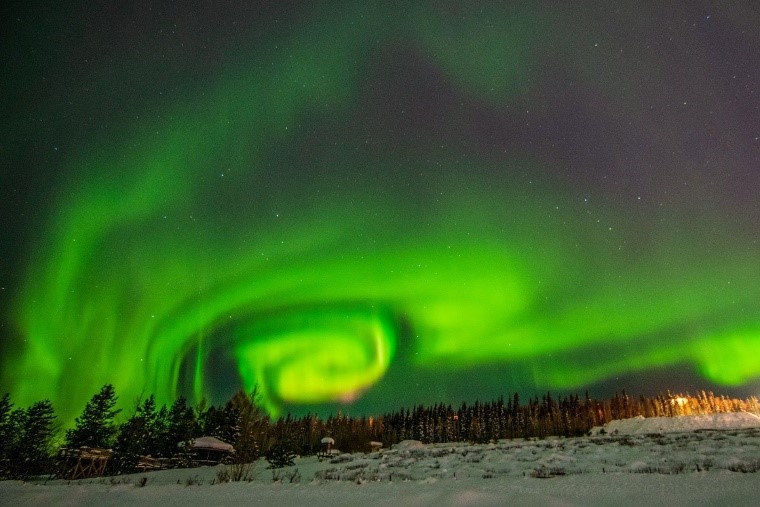Description

Disclaimer: Copyright infringement not intended.
Context
- For the first time, Northern Lights were seen in India.
Details
- The Indian Astronomical Observatory above Mount Saraswati captured a rare phenomenon as a geomagnetic storm struck Earth's magnetic field, creating unique auroras.
- Aurora Borealis was visible from as far as India's Ladakh (34-36°N).
- This was the first time that the aurora was captured on camera in India by the Indian Astronomical Observatory.
- The auroras are normally seen at higher altitudes in parts of Alaska, Norway, and other countries.
What causes auroras or polar lights?
- The Northern Lights and Southern Lights are natural light display that occurs in the polar regions.
- Aurora is triggered by an interaction between the plasma particles hurled by the Sun and Earth's magnetic field.
- They are caused by particles from the sun that enter the Earth's atmosphere and collide with gas particles, such as oxygen and nitrogen.
- When these particles collide, they release energy in the form of light. The different colours of the aurora are produced by different gases. For example, green auroras are caused by oxygen molecules, while red auroras are caused by high-altitude oxygen atoms.
- The reason why the polar lights are more visible in the polar regions is that the Earth's magnetic field traps these particles near the poles, causing them to interact with the atmosphere and produce a beautiful display of light.
- The strength and frequency of the lights depend on the activity of the sun. When the sun is more active, it releases more particles, which can result in more frequent and intense auroras.

Why are we seeing the Northern Lights more often now?
- In the last two weeks, the Northern Lights have been seen in parts of the world where they were never been seen before. This recent Northern Lights viewing, according to scientists, is because the sun let off a large burst of energy.
- Every 11 years, the Sun's magnetic cycle ramps into overdrive. [Solar Cycle]
- At the height of this cycle, known as solar maximum, the Sun's magnetic poles flip.
- This produces a greater number of sunspots, more energy and cause solar eruptions of particles.
- This activity on the sun - a solar storm or coronal mass ejection - causes the auroras.
- And this process increases and is more visible when the Sun goes through this natural, 11-year cycle.
- We're right in the middle of that transition right now; we're approaching it. When we hit the middle we call it solar maximum. It's when we have the most sunspots it's when we get the most solar flares and eruptions and more auroras.
Solar storms
- Solar storms are disturbances in the Sun's magnetic field that can release large amounts of energy into space in the form of charged particles and electromagnetic radiation. The most common types of solar storms include solar flares, coronal mass ejections (CMEs), and high-speed solar wind streams.
- The effects of solar storms on the Earth can vary depending on the strength and type of the storm. The charged particles from a solar storm sometimes interact with the Earth's magnetic field, causing colorful polar lights.
- But these storms cause other disruptions and can affect the Earth in many ways:
- Power outages: Strong solar storms can cause power grid disturbances by inducing electrical currents in long power lines, which can lead to blackouts and other electrical disruptions.
- Satellite and communication disruptions: Solar storms can interfere with satellite communication and navigation systems, causing disruptions to GPS, satellite TV, and other services.
- Radiation exposure: Solar storms can increase radiation levels in space, which can pose a risk to astronauts and people at high altitudes.
- Increased risk of space debris: During a solar storm, the Earth's atmosphere can expand, which can increase drag on orbiting satellites and space debris, leading to a higher risk of collisions with other objects in orbit.
SOLAR CYCLE: https://www.iasgyan.in/blogs/solar-cycle
|
Indian Astronomical Observatory (IAO)
The Indian Astronomical Observatory (IAO) is a high-altitude astronomy station located in Hanle, India and operated by the Indian Institute of Astrophysics. Situated in the Western Himalayas at an elevation of 4,500 meters (14,764 ft), the IAO is one of the world's highest-located sites for optical, infrared and gamma-ray telescopes. It is currently the tenth-highest optical telescope in the world. It is India's first dark-sky preserve.
The Indian Astronomical Observatory stands on Mt. Saraswati, Digpa-ratsa Ri, Hanle in south-eastern Ladakh union territory of India. Accessing the observatory, located near the Chinese border (Line of Actual Control), requires a 250 km long ten-hour drive from Leh city, the headquarter of Leh district
|
|
PRELIMS PRACTICE QUESTION
Q. Which of the following statements are correct?
a)Aurora is triggered by an interaction between the plasma particles hurled by the Sun and Earth's magnetic field.
b)Green auroras are caused by Sulphur molecules, while red auroras are caused by high-altitude Nitrogen atoms.
c)The effect is known as the aurora borealis in Southern hemisphere latitudes. In Northern hemisphere latitudes the effect is known as the aurora australis.
d)Auroras also occur on other planets in our solar system including Jupiter, Saturn, Uranus, Neptune and Mars.
1. a and b only
2. a, b and c only
3. b, c and d only
4. a and d only
Answer: 4
|

https://www.indiatoday.in/science/story/never-before-seen-aurora-dazzle-skies-in-ladakh-watch-2366867-2023-05-01
NOTE: PATENTS ACT IN NEWS:
READ
https://www.iasgyan.in/daily-current-affairs/patent#:~:text=The%20Patents%20Act%2C%201970empowers,infringement%20of%20the%20patent%20rights.
https://www.iasgyan.in/daily-current-affairs/intellectual-property-rights-ipr
















